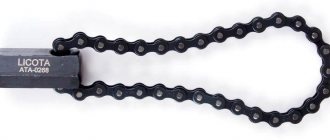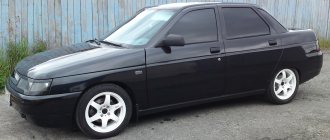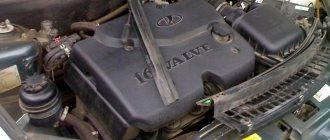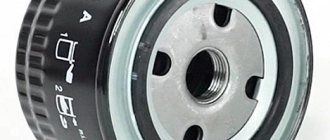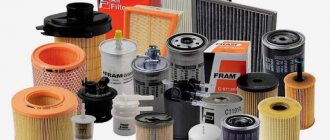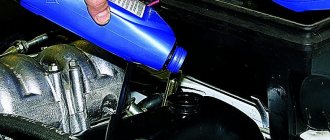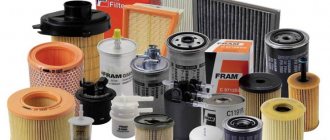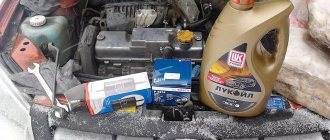Replacing consumables is a process that every car enthusiast has to deal with. The market offers a wide range of oil purification filters from different manufacturers, which greatly complicates the choice: not every car owner can choose exactly the filter that will guarantee long-term and reliable operation of the car engine.
Efficient and long-term operation of a car engine is only possible with proper care and protection. A high-quality oil filter guarantees this.
During vehicle operation, engine oil becomes contaminated with combustion products and small metal particles. Working surfaces are protected from such debris only by an oil filter, which ensures normal operation of the power unit in different conditions - both in normal mode and in extreme conditions, for example, when starting in the cold season.
Oil filter requirements
A high-quality oil filter must meet the following requirements:
- The filter element must retain microscopic metal particles and other contaminants.
- A mandatory requirement is to maintain continuous oil circulation in the system. The bypass valve is responsible for this even when the filter is completely dirty.
- Prevent the outflow of engine oil into the crankcase of a stopped engine in order to protect the engine from dry starting and instant supply of lubricant into the line, which ensures timely lubrication of rubbing surfaces. The filter's anti-drainage valve is responsible for this function.
How much will the resource increase?
It’s very difficult to say for sure guys! After all, it all depends on the “lubricant” you pour, on the “MOT” interval, on your driving style (whether you rev the engine or not)! However, I think that the increase will be decent, because think for yourself - the oil will always remain as clean as possible, without soot, chips and other deposits. If you undergo maintenance every 10,000 kilometers (changing all filter elements accordingly), engine wear will be minimal. I assume that at a minimum, the resource will increase by 30 - 40% of the total mileage. And you know this is essential!
I know you have a mess in your head right now - “what and how” is probably not so clear from the article, so let’s watch a detailed video in which I put everything on the shelves. WE WILL CUT THE FILTER AND SEE WHAT'S INSIDE.
And now there’s a vote, I’m wondering: would you put such a filter on your car or not?
That's all, I think the invention is worthy, I recommend it to everyone. Read our AUTOBLOG.
(
17 votes, average: 4.41 out of 5)
Similar news
Distributed or direct injection (MPI or GDI). Which .
Hydraulic compensators or pushers (of valves). What's better?
Scuffing and “spinning” of liners in the engine of Korean cars. KIA (O.
Add a comment Cancel reply
What to look for when choosing an oil filter?
LADA car engines, on which Salyut oil filters are mostly installed, have some design features. The filter in them is placed at an angle in an almost horizontal position, and not vertically, as in other car models. Due to this situation, the requirements for oil filters are very stringent.
The best oil filter today is considered to be the Salyut filter, which is one of the highest quality. Its development was carried out with the participation of AvtoVAZ specialists, taking into account all the features of LADA car engines. Accordingly, for VAZ cars, the Salyut oil filter is optimal and most suitable. And why all?
Because Salyut brand oil filters have design features that make them best suited for LADA cars.
Anti-drain valve
The flow of oil from the engine into the crankcase is prevented by an anti-drainage valve. This function is important, since otherwise the engine will start “dry”. Car owners often encounter this in situations where a low-quality oil filter is used: increasing the load on the engine during its startup and the first minutes of operation accelerates its wear. Visually, a high-quality and best oil filter can be determined by the oil pressure light: it should turn off immediately after the engine starts running. Many filter element manufacturers use molded rubber to create anti-drainage valves, which loses elasticity over time. A valve of an original spring design is installed in the Salyut oil filter housing, which maintains the functionality of the valve throughout the entire service life of the filter.
Specifications
You can get acquainted with the characteristics of TNK 75W90 oil from the table:
| Parameter | Test method | Value/Units |
| Kinematic viscosity at 100 °C | GOST 33 | 15.5 mm2/s |
| Dynamic viscosity at a temperature of -40°C | GOST 1929 | 97300mPa∙s |
| Viscosity index | GOST 25371 | 170 |
| Tribological characteristics for ChShM: | GOST 9490 | |
| Bully index | 661 N | |
| Welding load | 2930 N | |
| Wear index at axial load 392 N for 60 minutes | 0.43 mm | |
| Flash point in open crucible | GOST 4333 | 205 °C |
| Pour point | GOST 20287 | -49 °C |
| Corrosion of a copper plate at a temperature of 120 °C, during. 3 hours | GOST 2917 | 1 point |
| Density at 20 °C | GOST 3900 | 879 kg/m3 |
Bypass valve
Oil starvation of the car engine is eliminated due to this part, which ensures a continuous flow of lubricating fluid into the system. Oil flows into the engine even if the oil filter is completely clogged or the liquid itself has thickened under the influence of low temperature. Car owners, in reviews of the Salyut oil filter, note the advantage of its design, in which the valve is located in close proximity to the inlet openings, so that when it is opened, all accumulated dirt is not washed off into the line. The valve opens under a certain pressure, the value of which is controlled by the manufacturer on all manufactured filters.
Replacing the oil filter
From a maintenance point of view, in most engines the oil filter is located very inconveniently, which forces car owners to work from the inspection hole when it is necessary to replace it. The specific location of the filter is usually indicated in the vehicle's operating manual.
The oil filter housing is often difficult to remove due to the fact that it sticks to the mounting flange. In such a situation, you can remove the filter using a homemade or proprietary oil filter wrench.
You can also unscrew the oil filter using a regular screwdriver: it can be used to make holes in the housing. It is advisable to choose the locations for the holes in such a way as not to touch the central fitting.
Replacing the filter element itself is simple. Before installation, experts often recommend filling the new filter 3/4 full with engine oil and screwing it into the mounting flange manually: after the filter housing gasket is screwed onto the flange, the filter is turned another 4/5 of a turn. The tightness of the oil filter installation depends on the condition and quality of the gasket.
When installing a new Salyut oil filter, you cannot use the old gasket - it must be changed along with the filter. The gasket material is destroyed under the influence of a mixture of hot engine oil, antifreeze and gasoline, which can lead to serious leaks even in the absence of visual signs of damage.
Advantages and disadvantages
Transmission oil TNK 75W-90 has the following advantages:
- the best additives to protect synchronizers and gears at elevated temperatures and loads;
- high stability to mechanical destruction;
- oil film strength during the entire replacement interval;
- effective protection against corrosion, foaming, oxidation, and deposit formation;
- compatibility and complete safety for modern elastomeric materials;
- reduction of noise and vibration of the gearbox during idling and driving;
- wide temperature range of use;
- reduction of fuel consumption;
- reduction in service costs.
The oil is somewhat thinner than many similar ones, but it copes with all the tasks assigned and maintains the specified temperature range.
Rolling
The original oil Salyuts are distinguished by double rolling, which is a technological bevel located in a circle. The counterfeit does not have this feature: its connection is uniform along the entire circumference, in some places traces of deformation of the surface of the case are noticeable, which are left by the roller during the process of installing the case and the cover.
Case color
The housings of branded oil filters are painted with matte paint, which under directional lighting gives a single, uniform highlight along the entire length of the housing. Fake filters are painted with a glossy dye, which is noticeable to the naked eye. In general, the body of the fake is very similar to the original, however, small flaws and unpainted areas are noticeable.
Despite their quite presentable appearance, fake oil filters are characterized by low-quality filter paper, incorrectly cut or deformed curtains, leaky connections and other shortcomings.
Another sign by which you can identify fake filters is the price: branded Salyut oil filters are more expensive than fake ones, which is why car owners buy fakes. The cost of original filters is 150–200 rubles.
Ways to distinguish a fake
Installing a counterfeit is fraught with accelerated wear of friction pairs and rapid failure of the motor. Therefore, it is important for a car owner to be able to distinguish a fake from an original in time, even before installing the consumables on the car.
Original Livna filters are very poorly protected from counterfeiting. Consumables have several types of packaging that differ in design. At the same time, the quality of the image and the cardboard itself is not particularly high. Therefore, when examining the box, counterfeit can only be detected if there are obvious printing or typographical flaws.
The size of the original box always corresponds to the dimensions of the filter housing. A counterfeit consumable can easily dangle in the packaging or fit too tightly.
A counterfeit can be identified by defects in the application of inscriptions on the body. In this case, the original may have a regular sticker, which is easy to fake.
In some cases, a counterfeit can be easily identified by obvious typographical and spelling errors on the case or packaging.
According to official statements from the manufacturer, a slight deviation in dimensions is possible during the production of filters. Therefore, it is impossible to detect a fake based on different sizes.
Inspection of the thread also allows you to detect counterfeit.
The original Livna oil filter has high-quality painting. Any defects in color or stamping indicate that the consumable is of counterfeit origin.
In some cases, the fake filter has obvious flaws, for example, the absence of holes for the passage of lubricant.
Be sure to inspect the O-ring. In the original it is made of elastic rubber.
